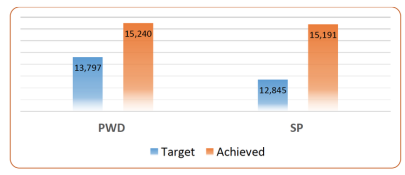Inclusion of the Vietnamese with Disabilities
OVERVIEW
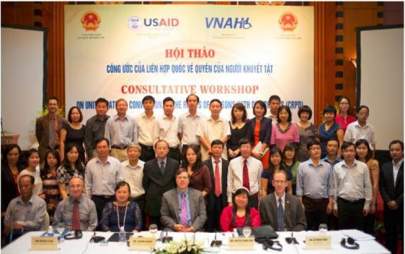
The overall goal of the program is a greater opportunity for the inclusion of Vietnamese with disabilities (IVWD).
With funding from USAID, IVWD has worked in partnership with the Government of Viet Nam and local partners over the past 10 years to develop policy, promote the employment of persons with disabilities and enforcement of policies as well as capacity building for coordination of disability policies and programs.
IVWD has reached more than 30,000 services providers and persons with disabilities from urban to rural area across the country through policy development, trainings, job fairs, accessibility of transportation, information. The project also provided support and capacity building for health workers, social workers, bus drivers, educators to address the needs of supporting persons with disabilities. IVWD also initiated the foundation and long term capacity building of DPOs, VFD, NCCD – organizations of and for persons with disabilities.
This booklet provides the readers with an overview and achievements of the project and further detail of the projects under the 5 major components:
- Component 1. Develop a stronger disability legal and policy framework
- Component 2. Strengthen disability policy coordination and enforcement
- Component 3. Empower Persons with Disabilities and Disability Community (Disabled People Organization and Self Help Groups)
- Component 4. Develop human resources in social work with disability and vocational rehabilitation
- Component 5. Promote employment and vocational training/rehabilitation
We would like to acknowledge the contributions and partnership of Viet Nam Government both at national level (MOLISA, MOH, MOET, MIC, MOIT, VCCI, Ha Noi Medical University, ULSA, USSH, VYA) and at the provincial level (DOLISA, DOH, DOET, ESCs of Tay Ninh, Binh Phuoc, Dong Nai, Quang Nam, Thai Binh, Da Nang etc) as well as non-government partners, DPOs, persons with disabilities and the dedicated project team.
Sincerely,
Toan Bui (Chief of Party)
PARTNERS & GRANTEE
1. Central
MOLISA
MOH
MIC
MOC
MOIT
MOT
VCCI
VFD
NCCD
USSH
ULSA
VYA
2. Provincial
Binh Phuoc
DOLISA
DOH
Da Nang
DOC
DOLISA
Dong Nai
DOH
Ha Noi
DPO
Ninh Binh
DOC
DPO
Quang Nam
DPO
DOC
Thai Binh
DOC
DOLISA
DOH
DPOs
Tay Ninh
DOH
Provincial Rehabilitation Hospital
Ho Chi Minh City
DOC
DOT
DPO
A. VISUAL NUMBERS:
Number of policy drafted: 15.
- Below are major disability policies that were developed with IVWD supports over the past 10 years:
- Disability Law and its key implementation Decree (28) and Circular (37)
- CPRD ratification
- Administrative Penalty Decree (inclusive of provisions on violations related to disability)
- Barrier-free access code and standard in construction (additional codes, for visual and hearing impairment)
- Accessibility standard for bus/train and regulations on accessible public transportation
- Accessibility standards in ICT
- Disability provisions in Vocational Training Law and Labor Code
- National disability action plans (NAP, period 2006-2010 and 2012-2020)
- National rehabilitation action plan (NAPR, 2015-2020)
- National action plan for vocational training (NAPVT)
Number of service providers trained and persons with disabilities benefited:
B. PROGRAM RESULTS
COMPONENT 1. DEVELOP A STRONGER DISABILITY LEGAL AND POLICY FRAMEWORK
1. UN Convention on the Rights of Persons with Disabilities on 28 November 2014 by VN National Assembly
The Convention on the Rights of Persons with Disabilities was officially ratified by the Vietnam National Assembly on November 28th 2014. This milestone achievement was the result of a long process of advocacy, recommendations and justification by MOLISA, related government agencies, disability advocates and disability community to promote for the CRPD ratification. IVWD was a major contributor to this achievement through technical assistance, developing and consultation for the proposal on CRPD ratification, and continued technical support during hearing sessions at the National Assembly.
2. National Law on Disability is enacted on 17 June 2010
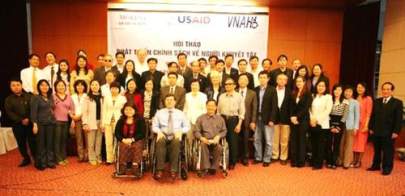
The national Law on Disability, the highest legal framework on disability that influences more than 10 million of persons with disabilities in the country. The enactment of the Law also resulted in improvement in sector policies that ensure equal opportunities for persons with disabilities to access all aspects of the society, such as policies in social protection, employment, education, health care, construction, transportation.
3. National Disability Action Plans (NAP) approved by Prime Minister
The National Action Plan to support people with disabilities (NAP) for the 2006-2010 period, approved under the Prime Minister’s Decision No. 239 in late 2006, is an impactful achievement in mainstreaming the disability agenda into national planning and programming works.
As a result, actual GVN budget disbursed for NAP 1 (2006-2011) as follows
- 2007: VND 10 billion or U$ 470,000
- 2008: VND 16.6 billion or U$790,000
- 2009-2010-2011: VND 20 billion or U$ 1 million each year
IVWD supported the development of the 2nd NAP for the 2011-2020 period, which was approved by Prime Minister’s Decision No. 1019 on 05 August 2012. A total of VND 78,25 billion was disbursed at central level during 2012-2015. At provincial level (61 provinces), and estimate of VND 60 billion has been disbursed.
National Action Plan on Rehabilitation by MOH and local rehabilitation plans
The National Action Plan on Rehabilitation (NARP) was approved by Ministry of Health (MOH) Decision No. 4039/QD-BYT dated 06 October 2014. The NARP of Thai Binh, Binh Dinh, Binh Phuoc provinces was developed and approved with the assistance of VNAH.
Some of key NAPR targets are as follow:
- 100% provincial hospitals have rehabilitation departments,
- 90% of CHS have qualified and trained staff working on rehabilitation,
- 90% of district hospitals have staff trained in occupational therapy,
- 100% of rehabilitation hospitals at national level will have developed technical expertise in rehabilitation, rehabilitation job code,
4. National Action Plan on Vocational Training was made by a MOLISA's Directive on Vocational Training to all provinces
In FY15 MOLISA issued a Directive (3930/LĐTBXH-TCDN dated 21 October 2014) to all provincial Peoples’ Committees to request strengthening of vocational training and employment for persons with disabilities. This Directive provided a platform for provinces to develop their local action plans. It also requested local governments to allocate 20% of the fund (from the national target program for vocational training for rural workers) or an amount equivalent to $10 million a year for vocational training of PWD.
5. Disability Mainstreaming
- Disability mainstreaming in Vocational Training Law
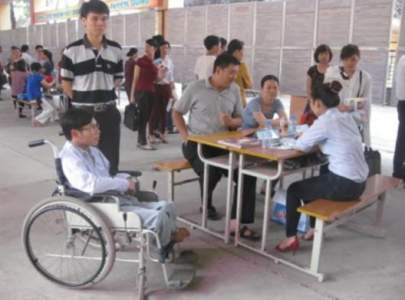
As result of IVWD supports, the Vocational Training Law, which was approved by the National Assembly in 2007, included an entire Chapter with six articles related to vocational training for people with disabilities. Disability mainstreaming into Vocational Training Law as a result of this program, which enabled large number of persons with disabilities to access vocational training and obtain employment, also opened up opportunities for further inclusion of disability issue in related planning/programming at national and local levels.
- Disability mainstreaming in amended Labor Code
On June 18, 2012, the amended Labor Code was officially enacted by the National Assembly of Vietnam. The new Labor Code, with 4 disability-friendly articles and a chapter of 3 disability-specific articles, is more disability-sensitive and ensures equal opportunity and removal of discrimination against persons with disabilities at work or access to job opportunities. It supported MOLISA to include articles concerning PWDs in the Labor Code.
- Incorporating disability into the National Household Living Standards Survey
VNAH worked with the World Bank, MCNV and NCCD to support the General Statistics Office to incorporate a disability module that adopted the International Classification of Functions (ICF) approach in the Vietnam Household Living Standards Survey of 2006-2008 The survey was completed and report released by the General Statistics Office in early 2008 with the following findings: Disability prevalence in Vietnam is 15.3% and Viet Nam more than 12 million persons with disabilities.
6. Accessibility codes and standards
- Accessibility codes and standards in construction
During the 2006-2008 period, VNAH supported the Ministry of Construction (MOC) to revise the accessibility codes and standards. Barrier free access have been complied in many major public facilities, including:
- Airports in Hanoi, Ho Chi Minh City, Danang,
- Downtown sidewalks in larger cities and major public transport systems,
- The metro in Hanoi and Ho Chi Minh City
- The light train in Hanoi
7. Accessibility codes and standards in transportation
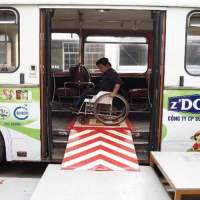
Another major achievement of the program was the inclusion of accessible transport for persons with disabilities in the revised Transportation Law, which was enacted in 2008.
Some of policy results assisted by IVWD:
- Revised transport law on 2008 included accessible transport and transport for persons with disabilities
- Decision 21/2006 BGTVT on standard 22TCN247, 22TCN302 for train and bus
- Decision 03/2008 BGTVT for 3 wheel motor-cycle operated by PWD
8. Information and Communication Technology (ICT)
Among major achievements of the IVWD program were the enactment of a Circular on ICT accessibility and 03 national accessibility standards on ICT, including:
(i) National standards on Public Internet Access Points (PIAP),
(ii) National standards on ICT Accessible Products and Services and
(iii) National standards on access to telecommunication.
COMPONENT 2. STRENGTHEN DISABILITY POLICY COORDINATION AND ENFORCEMENT
1. Accessibility Enforcement Units on Construction
During 2006-2008, five Accessibility Enforcement Units on Construction were established under the Departments of Constructions (DoCs) of Ninh Binh and Quang Nam, Danang, Hanoi and Ho Chi Minh City provinces to promote enforcement of the barrier-free accessibility standards in construction
- Several training for designers, blue prints examiners and licensing officials were conducted in these provinces.
- Local units reported that 55 public works in Ninh Binh and Quang Nam were made accessible
2. Disability Information System (DIS)
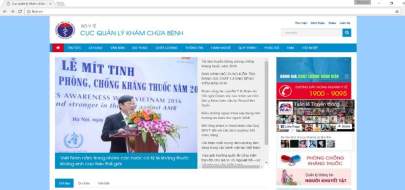
The Disability Information System (DIS) is one of the most impactful achievements of the IVWD program. Starting in Da Nang as a pilot model since 2009, until now DIS has been successfully replicated to 14 provinces. IVWD collaborated with PDSP/DAI to expand DIS in some of these provinces. By the end of December 2015, DIS data has a total of 376,300 records (of individuals with disabilities) in 14 provinces where DIS is currently being in use. At the central level, The program supported MOH to install and operate national DIS system based at the Bureau of Medical Administration (for MOH) and at NCCD (for MOLISA) that would enable disability data collection and reporting at national level.
3. Strengthened NCCD and M&E
National Coordinating Council on Disabilities (NCCD)
The program supported the establishment of NCCD in 2002, and continued supports and partnerships for its operation until recently. Over the years NCCD was recognized for its roles within the GVN as a focal point for promoting disability policy development, planning, and coordination, monitoring and a driving force behind the enactment of the Disability Law, the NAP and related policies guiding implementation of the Law. NCCD with the assistance of IVWD developed and enforced the M&E framework which covers 9 disability related components.
4. Penalty Decree was enacted
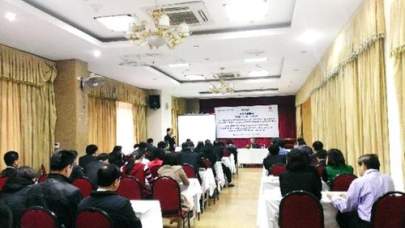
The Decree of Administrative Fines for Violations of the Disability Policies which covers all sectors related to persons with disabilities including employment, vocational training, education, health care, accessibility and others, approved by the Government/Decision 144 on 29 October 2013.It regulates the acts of violations, the corresponding fines for those acts and responsibilities of authorized government bodies in imposing and executing penalty/fines. This is a strong measure for enforcement of the national law on disability.
5. Standard Procedures on Disability Services
VNAH supported SPD/MOLISA in the development and finalization of MOLISA Circular on Case Management for Persons with Disabilities, resulting in the approval of the Circular 01 on the 6th of January 2015. This is the first legal document that regulates the process for delivering services for persons with disabilities, and the roles of social workers and other related stakeholders at all levels to ensure the coordination of the services.
6. Developing training package and delivering training on disability policies, disability rights and rights claim procedures
A standardized disability policy training package for training of local government officials and DPO leaders was completed by MOLISA through IVWD support. It is noteworthy that this is the first standardized training package that covers all areas of social/employment, education, health care, accessibility policies for persons with disabilities.
- 3,000 copies of the training materials have been printed and distributed to provinces, social work centers, universities and DPOs.
- 26 resource trainers including government officers, services providers, lecturers and DPO leaders was developed.
- 28 training sessions were delivered and benefited a total of 852 DPO leaders and persons with disabilities of 07 provinces.
- 03 training sessions were delivered and benefited for 122 local government officers of 03 provinces (Thai Binh, Tay Ninh and Binh Phuoc)
COMPONENT 3. EMPOWER PERSONS WITH DISABILITIES AND DISABILITY COMMUNITY (DISABLED PEOPLE ORGANIZATION AND SELF HELP GROUPS)
1. Vietnam Federation on Disability (VFD) was legalized
In 2010, the Vietnam Federation on Disability was established as an organization to coordinate communication and networking with all DPOs, self help groups, and local NGOs working as advocates for persons with disabilities. IVWD has supported its mobilization and formation efforts, in conjunction with NCCD. IVWD provided training in advocacy and leadership to VFD and supported staff and a local consultant to assist them in establishing a strategic plan to further define and carry out their mission.
2. Local DPO set up
VNAH supported to establish DPOs in Hanoi, Ninh Binh, Quang Nam and Da Nang provinces. Training was provided in advocacy and leadership and this encouraged the DPOs to assist and support other self help groups wanting to become DPOs. Following additional DPOs included Binh Dinh and at the district level Dai Loc, Dien Ban, Tam Ky, Duy Xuyen, and Nui Thanh.
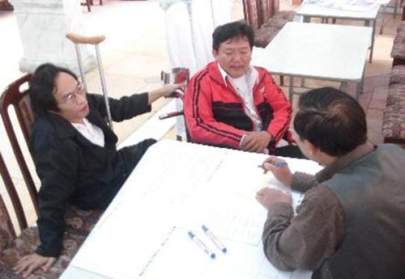
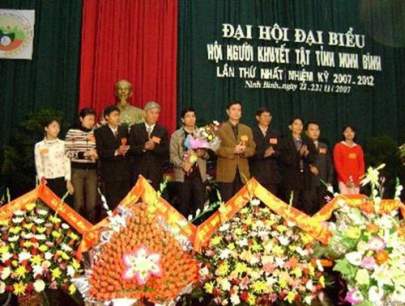
COMPONENT 4. DEVELOP HUMAN RESOURCES IN SOCIAL WORK WITH DISABILITY AND VOCATIONAL REHABILITATION
1. Human resources in social work with disability
IVWD has partnerships with national universities to develop textbook on social work with persons with disabilities for both the B.A. and M.A. levels, develop a cadre of master trainers, program field work.
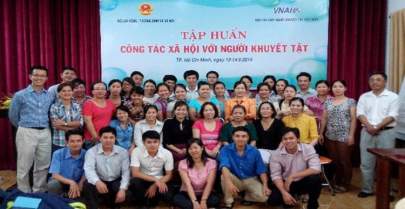
- 600 copies of the textbook for the long course on social work for persons with disabilities were printed and distributed to 47 universities and Social Work agencies nation-wide.
- 37 lecturers from 15 university faculties were trained on the long course materials and committed to teach this at their respective universities. The training curriculum is now being taught at Hanoi University of Social Sciences and Humanity.
- A textbook for the short course on social work for persons with disabilities for vocational training colleges was developed. The curriculum is being adopted in training program at ULSA.
- 350 copies of the short course lesson plan were printed and distributed,
- 38 lecturers from 14 universities and colleges were trained as trainers on the short course materials.
- 03 training modules for frontline social workers were developed and 600 copies were printed and distributed.
- Social work fieldwork in implementing the social work for disabilities manual was completed, printed and distributed. 40 undergraduate social work students participated in a four week field work program at several non government organizations, social work and Social Protection Center, center for autism.
2. Vocational rehabilitation training curriculum
The development of the vocational training curriculum was led by the Hanoi Medical University with technical assistance from an U.S expert/lecturer of vocational rehabilitation.
- 04 medical universities (Hanoi, Hai Phong, Thai Binh and Thai Nguyen) used the curriculum in their teaching of vocational rehabilitation with medical students.
- 100 copies of the community based vocational rehabilitation manual with the target audience as community VR practitioners was published.
3. University Curriculum on Accessible Transport
The program has successfully assisted Hanoi University of Transportation (HTU) in the development of a first curriculum on accessible transport to train second year students. International experience from USA, UK, Canada, Brazil and comments from Vietnamese experts, persons with disabilities were shared and incorporated into the final curriculum.
COMPONENT 5. PROMOTE EMPLOYMENT AND VOCATIONAL TRAINING/REHABILITATION
1. Blue Ribbon Employers Council (BREC)
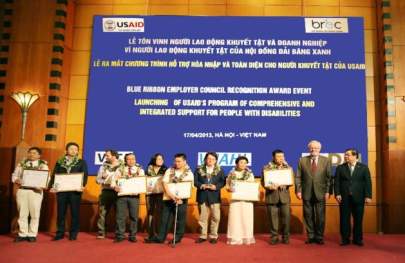
Blue Ribbon Employer Council (BREC), a national employer council established in 2007 through a cooperative agreement with Vietnam Chamber of Commerce and Industry (VCCI), BREC began with 25 members and now has 270 local and international employers including such major companies as Nike, IBM, Protec etc and Director Board members in 3 regions.
- BREC participated in revision of Labor Code, the employment law, and the law on vocational training.
- BREC business plan developed and implemented.
- 1,500 jobs generated for persons with disabilities.
2. Vocational rehabilitation service model in Hanoi and Danang
The Vocational Rehabilitation (VR) pilot in Danang was set up at the Danang Employment Services Center as the focal point. The network involved services providers including rehab hospitals, vocational schools, employers, social workers and CBR workers etc. It demonstrated an integrated service and one that is coordinated with relevant service providers in the community.
- Networks of 25 service providers signed up for Danang and 37 members for Hanoi- including employers, DPO, employment services – generated jobs for 82 persons with disabilities for the model in Hanoi and 28 persons with disabilities in Danang.
- The model was also recognized by Hanoi DOLISA with annual funding of 120,000,000 VND to support employment activities for persons with disabilities in fiscal year 2014.
3. Vocational Rehabilitation guidelines
VNAH supported the Bureau of Employment of MOLISA to develop guidelines on Vocational Rehabilitation as part of efforts to promote the expansion of Vocational Rehabilitation in Viet Nam. Guidelines helped ESCs to become more aware of persons with disabilities and better prepared to provide employment services for them.
The Guidelines was finalized, printed and distributed to all provincial Employment Service Centres (ESCs) nationwide.
03 training workshops on the provision of vocational rehabilitation and employment services for persons with disabilities were organized in Danang, Hanoi and Ho Chi Minh City. 70 representatives from all provincial ESCs, disability community, and vocational training centres and rehabilitation centres in the three regions were trained.

The GVN established an extensive and comprehensive framework of disability laws and policies to protect the rights of persons with disabilities. The ratification of CRPD has significant impacts in terms of political and legal aspects. First, Vietnam has shown its strong political commitment to protecting the rights of persons with disabilities specifically, as well as human rights generally. Second, by ratifying the CRPD, Vietnam Government commits to implement the Convention and further improve the legal framework for protection of the rights and inclusion of Vietnamese with disabilities.
Through technical assistance and capacity building, the program was able to expand and strengthen the capacity of NCCD, VFD, DPOs as service providers, as participants in law and policy formulation and as disseminators of law and policy information. As such, persons with disabilities were able to establish their presence within the government as they are now invited to provide public input into deliberations on policy issues.
Comprehensive and reliable national databases on adults and children with disabilities would improve the government’s ability to formulate, implement and coordinate laws and policies. At the central level, MOH has created a platform for the DIS linkage to the MOH website, MOLISA is intended to create a database on social protection recipient including persons with disabilities. At the provincial level, several provinces plan to continue to use DIS including Da Nang and Dong Nai, Thai Binh who have assigned staff to maintain the system.
A variety of methods were developed and implemented with VNAH assistance to provide vocational and employment supporting services including employment council (BREC), job preparedness and placement support. Staffs of Employment Service Centers noted that the vocational rehabilitation services will continue beyond the life of the program since it has become a routine activity.
VI. CHALLENGES
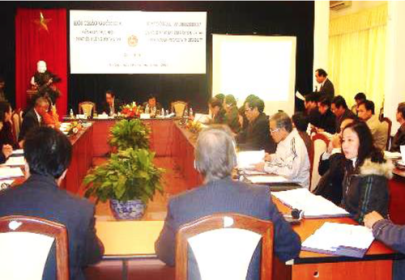

A variety of methods were developed and implemented with VNAH assistance to provide vocational and employment supporting services including employment council (BREC), job preparedness and placement support. Employment Service Centers noted that the vocational rehabilitation services will continue beyond the life of the program since it has become a routine activity.
The IVWD faced a number of constraints during this program period. There were frequent delays in program start up in the early stages of each phase. Many were the result of the busy schedule of government partners not only in negotiating the MOUs and Cooperative Agreements but also during the implementation of program activities. The partners had scheduling conflicts because of their other responsibilities which were sometimes of a higher priority to them, thus creating delays. Additionally, during the program there were structural changes within government partners because of staff changes at the higher decision making levels.
Another constraint was the time needed to bring greater awareness to government leaders about the principles of disability and a movement toward a rights based approach. This attitudinal change was time consuming but necessary if laws, policies, decrees, etc., were to move forward in a rights based direction; and if that movement included the full and active participation of persons with disabilities.
Obviously, the budget resources from the government was also a constraint, especially because if/when laws were enacted and policies were written, there needed to be major resources authorized for the implementation of these policies.
VII. ACRONYMS AND ABBREVIATIONS
BREC Blue Ribbon Employer Council
CHS Community Health Station
CSA Committee of Social Affairs, National Assembly
CRPD Convention on the Rights of Persons with Disabilities
DIS Disability Information System
DOC Department of Construction
DPO Disabled Person Organization
DOLISA Department of Labor, Invalids, and Social Affairs
ESC Employment Service Center
GVN Government of Viet Nam
ICT Information and Communication Technology
IVWD Inclusion of the Vietnamese with Disabilities
MOLISA Ministry of Labor, Invalids and Social Affairs
MOET Ministry of Education and Training
MOH Ministry of Health
MOJ Ministry of Justice
MOU Memorandum of Understanding
NAP National Action Plan on Disability
NCCD National Coordinating Council on Disability
TOT Training of Trainers
ULSA University of Labor and Social Affairs
USSH University of Social Sciences and Humanities
VCCI Vietnam Chamber of Commerce and Industry
VFD Vietnam Federation on Disability
VNAH Viet Nam Assistance for the Handicapped
VR Vocational Rehabilitation
VYA Vietnam Youth Academy


